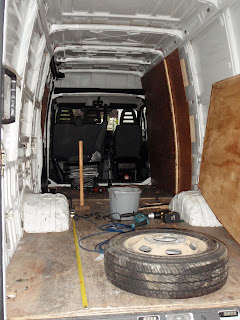
 After having built a camper on an old Dodge S50 series some years back, and having missed the traveling life, in August 2009 we decided we'd have another go - with the intention of getting it finished by summer of 2013.
After having built a camper on an old Dodge S50 series some years back, and having missed the traveling life, in August 2009 we decided we'd have another go - with the intention of getting it finished by summer of 2013.
After lots of research on base vehicle types, we plumped for a 3 litre diesel Iveco Daily, long wheel base, and
twin rear wheels. We liked the space, head room and good ground clearance - plus rear wheel drive. Having hired a Ducato camper in May of 2009 to see what a commercial build had to offer, we were underwhelmed by the really poor reversing capabilities on grass and a slight incline - given the sorts of places we were used to going. After reading loads of blogs about this model in particular, and front wheel drives in general, it had to be a rear wheeler!
We eventually tracked down the sort of Iveco we were looking for and took it for a test drive - this is it on the day! We got it from http://www.sloughvan.com/ - nice people to do business with!
These vans are cavernous - and there's a high top version with even more room than this - but we decided that this would be plenty!
After getting the van home we decided to sort out some of the basics before we started on the conversion. This included rust proofing the underside as the floor pan was in good nick and a liberal coating of Waxoyl would help keep it that way. Having toyed with the idea of doing it ourselves (and remembering the mess made just doing some wheel arches) we went down to Poole to see Phil at Rustbusters who did a cracking job! http://www.rustbusters.co.uk/

The next job was to sort the tyres out. We're likely to get off road some of the time and the low profile cheapo tyres the van came with weren't doing us any favours- so we upgraded to some 205/16 Mud and Snows from Nexen - better grip, better ride and more ground clearance! You can se below the difference in size - that's the inflated original spare on top of an un-inflated second hand M&S (another e-bay bargain!)
After the tyres were sorted we started looking for a single passenger seat to replace the double one as we will be making a bulkhead and need the space to walk through. After a few weeks on e-bay, managed to get one for £10 - bargain! It was easy to fit too, as although the seatbelt mount was on the wrong side, a bit of judicious drilling soon found the left hand drive belt mount under a plate - good as new! Well, not really, as both the seats are a bit tatty - but we found a great company that makes proper cloth ones http://www.van-seat-covers.com/ - much more comfortable!
At the same time we stripped out the original wall and ceiling ply lining and the ply bulkhead - leaving the floor to be insulated and built up on the original ply.




















